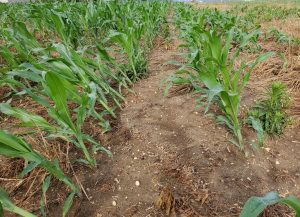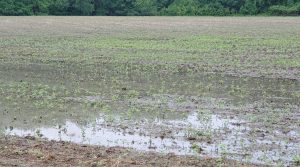June 9, 2021
Last night’s storm brought ground shaking lightening strikes and nearly an inch of rain to most of Salem County south of Route 40 and over two inches of rain north of Route 40 with pockets exceeding 2.3 inches near the Gloucester-Salem line.

Corn lean after deluge
Corn: Prior to the deluge preemergence herbicides were continueing to do their job with few examples of seedling weed flushes since planting. After the storm, corn in the v4 stage that recently received nitrogen is exhibiting rapid uptake and stem elongation.
Despite widespread signs of leaning from the deluge (the taller the corn, the more obvious the easterly lean), no signs of green snap were observed. However, plants are loosely rooted in oversaturated soils and may lodge further if another round of storms comes before surface soils drain.
Green snap is more of a threat after v8 stage when stems rapidly elongate prior to tasseling.
In these high rainfall areas, leaching of recently applied nitrogen has most likely occurred. Monitor crop condition in fields closely if side-dress nitrogen was applied just prior to these storms.
In areas of excessive precipitation, pay particular attention to signs that pre-emergence herbicide residiual activity has stopped controlling the weed seed bank. An indication is flushes of seedling ragweed, lambsquarters, pigweeds and seedling grasses.
Soybeans: Unfortunately many soybeans fields have ponding water at the moment and soiled seedlings up to v3 trifoliate stage.

Dry soil conditions and the intensity of the deluge splashed soil onto emerged leaves. Note these areas for outbreaks of bacterial foliar diseases after fields have canopied.
Soybeans do not like saturated conditions as their roots will quickly run out of air. Nitrogen fixing bacteria can also aphixiate, but plants generally recover well if sandy soils drain quickly. Monitor soybean fields closely for signs of damping off and root rot if ponding continues for more than 48 hours. The causative agents at this stage of development are most likely Fusarium spp, Rhizoctonia solani, Phytophthora sojae, and Pythium spp. After conditions return to normal, dig up plants and evaluate if nitrogen fixing bacteria survived and overall health of the roots.
Ivy leaf morning glory continues to be the most observed weed seen in bean fields right now but populations are sporadic giving some indication that previously applied herbicides have continued to work.

